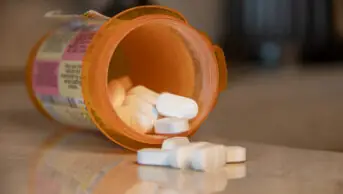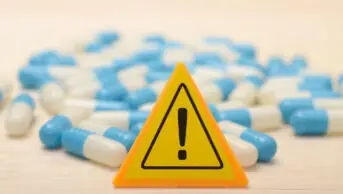
Shutterstock.com
In 2000, then chief medical officer Liam Donaldson published the report ‘An organisation with a memory’, which recognised that preventable harms were occurring frequently in the NHS and that safety breaches were being forgotten[1]
. Following the report, the National Patient Safety Agency (NPSA) and the National Reporting and Learning System (NRLS) were established in 2001 and 2003, respectively — two important events in the NHS’ 70-year history[2]
.
Many changes in the NHS have taken place since then. In 2012, the functions of the NPSA, which was originally established to monitor patient safety incidents, became part of the NHS Commissioning Board Special Health Authority (renamed NHS England in 2013) and, in 2016, NHS Improvement became the central body responsible for overseeing patient safety in England. But under these new arrangements, important risks to patient safety have not been adequately addressed and the NRLS, a database of patient safety incident reports, offers insufficient transparency and learning. The NHS is far from an organisation that remembers — it is failing to recall and use information and guidance previously published by the NPSA to improve patient safety.
The NHS cannot afford to forget: research suggests that around 66 million potentially clinically significant medication errors occur per year, with 71% of these taking place in primary care[3]
. Data show that avoidable adverse drug reactions — medication errors — are estimated to cost the NHS £98.5m per year, consume 181,626 bed-days, cause 712 deaths and contribute to 1,708 deaths. Another study found 556 medication-related harm events per 1,000 discharges, of which 336 (81%) cases were serious and 214 (52%) were potentially preventable. The annual cost of preventable discharge medicine-related harm to the NHS was estimated to be £243m[4]
.
Many more medication errors take place than are reported, but the NRLS was intended to provide helpful local and national incident data for learning and improvement. NHS Improvement’s latest review and response report from March 2018 describes how NRLS incident report data are currently analysed and acted on[5]
. It explains that most patient safety challenges, such as reducing diagnostic error, preventing self harm, avoiding falls or managing long-term anticoagulation, are “well recognised” and that these “giants of patient safety” are the focus of long-term NHS programmes. Although the document says that these programmes, including the Maternal and Neonatal Health Safety Collaborative and the Patient Falls Improvement Collaborative, are routinely informed by data collected through the NRLS, the focus of work at NHS Improvement seems to be identifying new risks to patient safety.
It says: “A national system can also identify new or under-recognised patient safety issues that may not be obvious at local level. When we identify these issues, we work with frontline staff, patients, professional bodies and partner organisations to decide if we need to issue advice and guidance to reduce risks in a warning alert, or if we can influence or support others to take action.” This is backed up by the patient safety alerts published in recent years, which appear to show that NHS Improvement is focused only on new or under-recognised risks.
This patient safety strategy raises some questions. Are the so-called ‘giant’ risks to patient safety sufficiently well known and are there up-to-date data on the number of NRLS reports received concerning these risks? What information is available concerning the long-term programmes — led by NHS Improvement working with partner organisations — to address these risks? Are health regulators, who inspect health service provider organisations, sufficiently aware and active in ensuring the ‘giant’ patient safety issues are being addressed?
Every six months, NHS Improvement publishes official statistics on patient safety incidents reported to the NRLS[6]
,[7]
. Sadly, the published information provides only national totals, and totals for individual NHS organisations, of the number of patient safety incidents reported, the level of harm and broad incident type (e.g. medication incident). This information is insufficient for learning and does not provide any information on the ‘giant’ risks to safe medication practice, which must account for a large proportion of the reported incidents.
Information supplied to me by NHS Improvement in response to a freedom of information (FOI) request reveals that of the 166,285 medication incidents reported by the NHS in England in 2017, there were 33,394 (20.1%) concerning wrong dose and frequency, 31,763 (19.1%) concerning omitted medicine doses, with 14,597 (8.8%) concerning the use of the wrong medicine[8]
.
In the past, the NPSA published more detailed analysis and learning on major risks to safe medication practice[9]
. My list of ‘giant’ risks to medication safety, based on the obtained FOI data and previously published NPSA materials, would include:
- Omitted medicine doses;
- Wrong dose and frequency errors, especially for opioids, anticoagulants and insulin;
- Unsafe use of injectable medicines;
- Wrong medicine use, often arising at transfers of care;
- Medicines given to patients who are documented to be allergic to the medicine.
All NPSA materials have now been transferred to the National Archive website, which is difficult to search using standard internet search engines[10]
. Thankfully, the NHS Specialist Pharmacy Service has published the NPSA medication safety materials on their website, which enables specific NPSA publications to be more easily found using internet search engines[11]
.
When first published, original NPSA materials were intended to be reviewed and updated regularly. It was recognised that these risks needed a combined ‘top-down and bottom-up’ approach to develop and implement actions to improve safer practice. For example, a new version of the patient-held yellow anticoagulant card and booklet, including guidance on safe use of the newer oral anticoagulants, would be very worthwhile.
On review of the NHS Improvement patient safety web pages, there is no information on the identity of ‘giant’ risks to medication safety. It is not certain that NHS staff would be able to describe all these risks.
There also does not seem to be any information on NHS Improvement or partner organisation websites concerning long-term programmes to address these ‘known’ risks to medication safety.
In the past, when the NPSA had issued Patient Safety Alerts about these ‘giant’ risks, the Care Quality Commission’s inspection process was criticised. There was concern that insufficient attention had been paid to ensuring that Alert guidance had been actioned[12]
. Now that information and guidance concerning these major risks has been archived, and no up-to-date NRLS report data or guidance has been issued, how does the Care Quality Commission and the General Pharmaceutical Council ensure adequate safeguards remain in force in NHS provider organisations to address these ‘giant’ risks?
It is interesting to review how the Joint Commission for the Accreditation of Healthcare Organizations, which operates in the United States and internationally, addresses major risks to safe medication practice. The commission links Sentinel Alert Guidance to their detailed medicines management standards, which are used for regular inspections of healthcare providers[13]
. These guidance and standards are not archived, remain active and are included in inspections until the risk to patient safety is no longer significant.
NHS Improvement’s current focus appears to be to identify new and under-reported patient safety issues. Although this is worthwhile, there is very little current information concerning the identity and number of reports to the NRLS of ‘giant’ risks to patient safety. There is also no information describing long-term programmes intended to address these risks. There is a danger that the ‘organisation with a memory’ is developing memory loss and is not addressing risks that account for the harms most commonly reported to the NRLS.
David Cousins is former head of safe medication practice at the National Patient Safety Agency and NHS England.
NHS National Director of Patient Safety, Aidan Fowler, said: “As an improvement organisation we are keen to listen to feedback and are committed to helping the NHS become the safest healthcare system in the world, which includes building on the important work of the National Patient Safety Agency. However, it is simply not right to suggest that the NRLS, the world’s largest patient safety incident reporting system, is not supporting learning or transparency. We are now developing plans to replace the NRLS with The Patient Safety Incident Management System, which will enable us to hear directly from patients and to learn from incidents more quickly. We are keen to hear from as many people as possible on the new system. You can get involved by visiting: https://improvement.nhs.uk/resources/dpsims-project-pilot/.”
References
[1] Donaldson L. An organisation with a memory: Report of an Expert Group on Learning from Adverse Events in the NHS. Chaired by the Chief Medical Officer. 2000. Department of Health. London, England
[2] Donaldson L. Building a safer NHS for patients: Implementing an organisation with a memory. 2001. Department of Health. London, England
[3] Elliot RA, Camacho E and Campbell F et al. Prevalence and economic burden of medication errors in the NHS in England. Policy Research Unit in Economic Evaluation of Health and Care Interventions. February 2018. Available at: http://www.eepru.org.uk/prevalence-and-economic-burden-of-medication-errors-in-the-nhs-in-england-2/#tab-1511252228-2-29 (accessed August 2018)
[4] Parekh N, Stevenson JM and Davies G et al. Incidence and cost of medication harm in older adults following hospital discharge: a multicentre prospective study in the UK. Br J Pharmacol 2008;84:1789–1797. doi: 10.1111/bcp.13613
[5] NHS Improvement. Patient safety review and response report April to September 2017. A summary of how we reviewed and responded to the patient safety issues you reported. NHS Improvement. 21 March 2018. Available at: https://improvement.nhs.uk/documents/2526/Patient_Safety_Review_and_Response_Report_Apr-Sept_2017.pdf (accessed August 2018)
[6] NHS Improvement. Analysis of the patient safety incidents reported in England to the National Reporting and Learning System (NRLS) up to December 2017 NHS Improvement. 21 March 2018. Available at: https://improvement.nhs.uk/resources/national-patient-safety-incident-reports-21-march-2018/ (accessed August 2018)
[7] NHS Improvement. Data workbooks on all patient safety incidents reported in England to the National Reporting and Learning System (NRLS). NHS Improvement. 21 September 2017. Available at: https://improvement.nhs.uk/resources/organisation-patient-safety-incident-reports-21-march-2018/ (accessed August 2018)
[8] NHS Improvement. Response to a Freedom of Information request from David Cousins. Received 13 July 2018
[9] National Patient Safety Agency. Patient Safety Report 4: Safety in Doses. 2007. Available at: http://webarchive.nationalarchives.gov.uk/20171030124156/http://www.nrls.npsa.nhs.uk/resources/?entryid45=59822&p=15 (accessed August 2018)
[10] National Patient Agency. Patient Safety Resources. Available at: http://webarchive.nationalarchives.gov.uk/20171030124133/http://www.nrls.npsa.nhs.uk/resources/?p=17 (accessed August 2018)
[11] National Patient Safety Agency. Patient (Medication) Safety Alerts from the NPSA and SPS resources to support their implementation. Specialist Pharmacy Service (NHS). Spcecialist Pharmacy Service (NHS). Published March 2018. Updated 28 June 2018. Available at: https://www.sps.nhs.uk/articles/patient-medication-safety-alerts-from-the-npsa-and-sps-resources-to-support-their-implementation/ (accessed August 2018)
[12] Action Against Medical Accidents. Implementation, monitoring and regulation of patient safety alerts. 2014. Available at: https://www.avma.org.uk/news/report-finds-cqc-blind-spot-re-patient-safety-alerts/ (accessed August 2018)
[13] The Joint Commission. Sentinel Event Alert: Issue 41: Preventing errors relating to commonly used anticoagulants. 24 September 2008. Available at: https://www.jointcommission.org/assets/1/18/sea_41.pdf (accessed August 2018)


